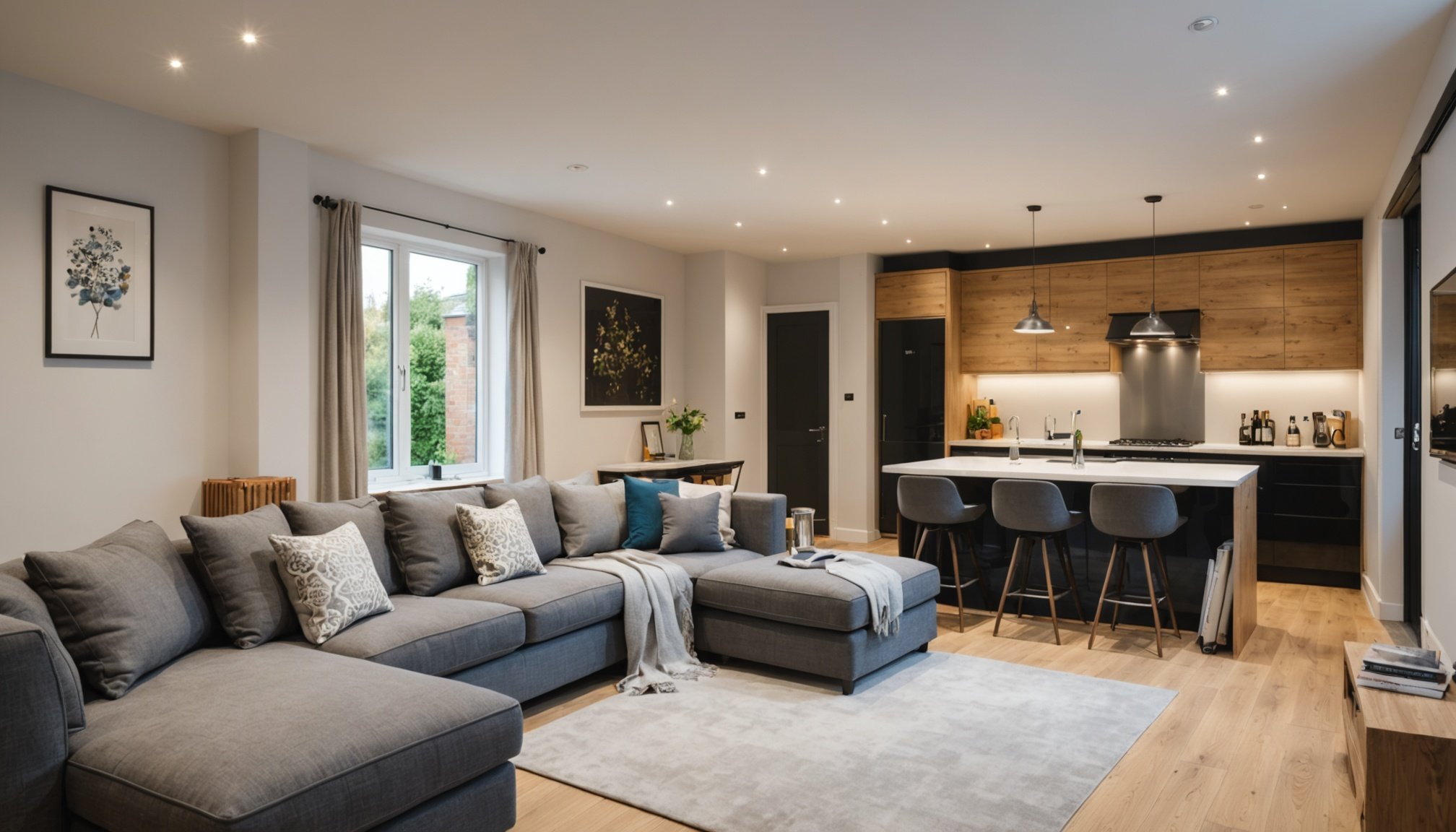Legal Regulations and Considerations for Basements
When planning basement construction in the UK, certain legal regulations and permissions must be adhered to. UK property law mandates compliance with basement construction guidelines to ensure safety and structural integrity. Building regulations specific to basements encompass critical factors such as fire safety, ventilation, and natural lighting.
Prior to any renovation or new builds, securing the essential planning permissions is crucial. This is particularly significant when altering existing baseline structures or working within conservation areas. It is advisable to consult with local authorities to understand the scope of permissions required. Historical properties add an extra layer of complexity, as maintaining the character and authenticity of the site may require specialized consent.
Also to read : Ultimate relocation handbook for uk homes with multiple fireplaces: crucial steps for a smooth move
Legal considerations extend beyond construction and renovation. Existing basement structures, especially within historical buildings, must comply not only with present guidelines but also with overarching heritage protection laws. This includes addressing any necessary archaeological assessments or consulting with preservation professionals to ensure compliance.
Being aware and informed about local UK property law will help mitigate potential legal challenges. Understanding these regulations not only assists in swift project approvals but also guarantees that basement transformations are sustainable and lawful. Adjusting plans according to legal stipulations ultimately results in better quality and safe residential spaces.
In the same genre : Mastering your home gym relocation: a comprehensive uk guide to seamless moving
Practical uses of basement spaces
Basements hold immense potential for enhancing home functionality through diverse and creative uses. A prevalent trend is transforming these spaces into extra living spaces or home offices. This not only optimizes available room but allows homeowners to tailor environments for specific needs, such as a dedicated gaming room or a serene office retreat. The potential for a functional layout encourages personalized touches, adapting the basement to suit varied lifestyles.
Consider implementing innovative design ideas to amplify the basement’s benefits. Installing built-in shelving or modular furniture can enhance storage use, keeping clutter at bay and rooms organised. Additionally, engaging with designers to evaluate lighting and decor choices significantly alters the perceived space, rendering basements cosy and appealing.
A thoughtfully designed basement impacts the entire house, offering a cohesive transition between levels through intelligent layout planning. Strategic use of the basement enhances home organisation, providing designated spaces for different activities, fostering a seamless flow throughout. Moreover, this adaptation transforms the homeowner’s perception of their living area, presenting a renewed appreciation and expanded view of the dwelling.
Harnessing the opportunity for basement utilisation, both creatively and practically, undoubtedly contributes to substantial home improvement. This approach can motivate and provide practical solutions to space limitations.
Insulation and Damp-Proofing Techniques
Ensuring a basement is safe and durable hinges on robust damp-proofing and effective insulation. Moisture often poses the greatest threat to basement spaces, leading to mould, rot, and structural damage. A proper damp-proofing approach is vital, forming a barrier that prevents water ingress and protects the basement’s integrity. This involves using high-quality membranes, sealants, and coatings designed specifically for subterranean environments.
In terms of insulation, achieving energy efficiency not only enhances comfort but also lowers utility costs. Insulating a basement can be done with materials like rigid foam boards or spray polyurethane foam, both providing excellent thermal resistance and added moisture barriers. Proper insulation ensures a stable indoor climate, making the space more usable throughout the year.
Preventing moisture issues and enhancing air quality in basements involves maintaining effective ventilation systems. Installing dehumidifiers and ensuring proper air circulation assist in curbing moisture accumulation. Moreover, utilising specialised vapor barriers and sump pump systems offer additional protection against potential water damage. When executed proficiently, these techniques collectively transform a basement into a healthy, safe, and habitable area. Implementing these strategies assures improved air quality and longevity of the space.
Potential for Conversion and Expansion
Transforming a basement offers an array of opportunities, not only enhancing a home’s living space but also potentially increasing property value. These basement conversions can range from creating a guest suite to developing a recreational room, depending on homeowner needs and preferences. When executed with precision and attention to detail, a converted basement can seamlessly integrate into the main living areas.
Planning considerations are crucial when undertaking such projects. Understanding the existing structure’s capacity for support, assessing water ingress possibilities, and ensuring adequate lighting and ventilation are fundamental. Engaging professionals to evaluate the basement’s structure ensures any expansion aligns with original construction guidelines. This forward-thinking approach is essential to create functional, safe, and attractive spaces.
An expertly designed basement not only amplifies the homeowner’s quality of life but also underscores the property value increase. In regions where space is a premium, such as dense urban areas, additional usable space significantly bolsters market appeal. Buyers often favour homes with completed basements, recognizing the immediate benefits offered. This home expansion strategy proves advantageous in a competitive market, offering both instant usability and long-term investment returns.
Impact on Property Value
Incorporating a functional basement space can substantially influence a property’s market value. Real estate experts suggest that the usability and size of a basement are key factors in determining its impact on home valuation. Homes with finished basements often enjoy a higher resale price due to the additional living area they provide, appealing to potential buyers who value space versatility.
A basement designed as a family room, guest suite, or home gym can drastically increase a home’s desirability, offering a competitive edge in the housing market. Properties in urban areas, where square footage is at a premium, especially benefit from completed basements. These added spaces facilitate multifunctional usage, which modern buyers appreciate.
Comparative market data highlights significant gaps in home prices between properties featuring finished basements and those without. This trend underscores the value that such enhancements bring, reflecting buyers’ preferences for homes that maximise usable space. Thus, a well-executed basement conversion is not just a luxury but a strategic investment, potentially providing a solid return by boosting the property’s appeal and economic worth.
Neighborhood considerations and market insights
Understanding how neighborhood trends influence basement construction can optimise investment decisions. Certain communities may prioritise expanded living areas, making basement renovations an attractive feature for potential buyers. Thus, recognising these community factors is crucial in evaluating a property’s long-term appeal.
Local property market trends significantly impact the viability of basement projects. Analysing nearby development activities and buyer demands helps homeowners align renovations with market expectations. This insight ensures that any basement improvement resonates with the wider property market, enhancing its attractiveness and functionality.
For instance, in neighbourhoods where space is at a premium, finished basements can offer a distinct advantage. More storage, additional rooms, and versatile layouts contribute positively to the overall property assessment. Engaging with local experts for neighbourhood analysis ensures informed planning, catering to preferences which influence local market dynamic.
Thoroughly evaluating community preferences and gauging reactions to basements and other features fosters better decision-making. Before undertaking significant changes, conducting research on specific market demands creates a strategic foundation, aligning basement enhancements with regional trends, making them more appealing in the property landscape.
Neighborhood Considerations and Market Insights
Understanding neighborhood trends is pivotal when considering basement constructions. Local communities often influence renovations, especially in terms of property market trends. Certain areas prioritise expanded living spaces, making basements a lucrative feature for potential buyers. Recognising these community inclinations is vital for assessing a property’s allure.
Exploring local property market trends provides homeowners with the direction needed for their projects. Analysing neighbourhood development activities and buyer preferences ensures renovations align with market demands, ultimately enhancing property functionality. For instance, in areas where space is at a premium, a well-executed basement project delivers a unique edge in the property market, offering storage and additional rooms.
Prioritising community factors fosters better decision-making. A meticulous evaluation of preferences concerning basements and other home features helps guide significant changes. By conducting thorough research into specific market demands, homeowners establish a strategy that syncs enhancements with regional trends. Such foresight assures that basement improvements resonate positively, making properties more attractive in the local real estate landscape. Engaging with local experts for neighbourhood analysis is encouraged to secure informed planning, catering to prevailing preferences which shape market dynamics.

